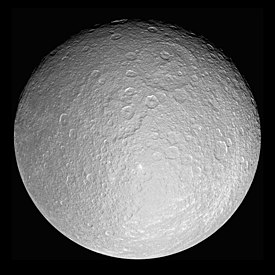 Cassini view of Rhea showing two adjacent impact basins | |||||||
| Discovery | |||||||
|---|---|---|---|---|---|---|---|
| Discovered by | G. D. Cassini | ||||||
| Discovery date | December 23, 1672 | ||||||
| Designations | |||||||
| Alternate name | Saturn V | ||||||
| Adjective | Rhean | ||||||
| Semi-major axis | 527 108 km | ||||||
| Eccentricity | 0.001 258 3 | ||||||
| Orbital period | 4.518 212 d | ||||||
| Inclination | 0.345° (to Saturn's equator) | ||||||
| Satellite of | Saturn | ||||||
| Physical characteristics | |||||||
| Dimensions | 1535.2 × 1525 × 1526.4 km[2] | ||||||
| Mean radius | 764.30 ± 1.10 km[3] | ||||||
| Surface area | 7 337 000 km² | ||||||
| Mass | (2.306 518 ± 0.000 353) × 1021 kg[3] (~3.9 × 10-4 Earths) | ||||||
| Mean density | 1.233 3 ± 0.005 3 g/cm³[3] | ||||||
| Equatorial surface gravity | 0.264 m/s² | ||||||
| Escape velocity | 0.635 km/s | ||||||
| Rotation period | 4.518 212 d (synchronous) | ||||||
| Axial tilt | zero | ||||||
| Albedo | 0.949 ± 0.003 (geometric)[4] | ||||||
| Surface temp. Kelvin |
| ||||||
| Apparent magnitude | 10 [5] | ||||||
| | |||||||

Rhea (pronounced /ˈriːə/,[6] or as Greek Ῥέᾱ) is the second-largest moon of Saturn and the ninth largest moon in the Solar System. It was discovered in 1672 by Giovanni Domenico Cassini.
Name
Rhea is named after the Titan Rhea of Greek mythology, "mother of the gods". It is also designated Saturn V.
Cassini named the four moons he discovered (Tethys, Dione, Rhea and Iapetus) Sidera Lodoicea (the stars of Louis) to honor King Louis XIV. Astronomers fell into the habit of referring to them and Titan as Saturn I through Saturn V. Once Mimas and Enceladus were discovered, in 1789, the numbering scheme was extended to Saturn VII.
The names of all seven satellites of Saturn then known come from John Herschel (son of William Herschel, discoverer of the planet Uranus, and two other Saturnian moons, Mimas and Enceladus) in his 1847 publication Results of Astronomical Observations made at the Cape of Good Hope, wherein he suggested the names of the Titans, sisters and brothers of Cronos (Saturn, in Roman mythology), be used.[7]
Physical characteristics
Rhea is an icy body with a density of about 1.233 g/cm³. This low density indicates that it is made of ~25% rocks (density 3.250 g/cm³) and ~75% water ice (density 1.000 g/cm³). Even though Rhea is the ninth largest moon, Rhea is only the tenth most massive moon.[8] Earlier it was assumed that Rhea had a rocky core in the center.[9] However measurements taken during a close flyby by the Cassini orbiter (see below) determined the axial moment of inertia coefficient as 0.4 kg·m².[10][11] Such a value indicates that Rhea has almost homogeneous interior (with some compression of ice in the center) while the existence of a rocky core would imply a moment of inertia of about 0.34.[9] The triaxial shape of Rhea is also consistent with a homogeneous body in hydrostatic equilibrium.
Rhea features resemble those of Dione, with dissimilar leading and trailing hemispheres, suggesting similar composition and histories. The temperature on Rhea is 99 K (−174°C) in direct sunlight and between 73 K (−200°C) and 53 K (−220°C) in the shade.
Rhea is heavily cratered and has bright wispy markings on its surface. Its surface can be divided into two geologically different areas based on crater density; the first area contains craters which are larger than 40 km in diameter, whereas the second area, in parts of the polar and equatorial regions, has craters under that size. This suggests that a major resurfacing event occurred some time during its formation.
The leading hemisphere is heavily cratered and uniformly bright. As on Callisto, the craters lack the high relief features seen on the Moon and Mercury. On the trailing hemisphere there is a network of bright swaths on a dark background and few visible craters. It had been thought that these bright areas may be material ejected from ice volcanoes early in Rhea's history when its interior was still liquid. However, recent observations of Dione, which has an even darker trailing hemisphere and similar but more prominent bright streaks, show that the streaks are in fact ice cliffs, and it is plausible to assume that the bright streaks on the Rhean surface are also ice cliffs.
The January 17, 2006 distant flyby by the Cassini spacecraft yielded images of the wispy hemisphere at better resolution and a lower sun angle than previous observations. While scientific analysis is still pending, raw images from the flyby seem to show that Rhea's streaks in fact are ice cliffs similar to those of Dione.
Possible ring system
On March 6, 2008, NASA announced that Rhea may have a tenuous ring system. This would mark the first discovery of rings about a moon. The rings' existence is inferred by observed changes in the flow of electrons trapped by Saturn's magnetic field as Cassini passed by Rhea.[12][13][14] Dust and debris appear to extend out to Rhea's Hill sphere, but are denser nearer the moon, and contain three narrow rings of yet higher density.
Exploration
Rhea has been imaged several times from moderate distances by the Cassini orbiter. There was one close targeted fly-by during the primary mission, at a distance of 500 km on November 26, 2005. An additional close flyby at a distance of 5,750 km was performed on August 30, 2007. One targeted encounter is planned for Cassini's two-year extended mission, a 100 km pass on March 2, 2010.




0 comments:
Post a Comment